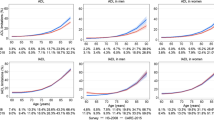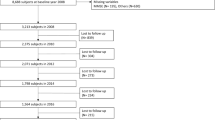Abstract
Background
The relationship between body mass index (BMI) and disability-free survival (DFS) remains unclear.
Methods
We conducted a 10-year prospective cohort study of 12,666 Japanese individuals aged ≥ 65 y. Information on BMI and lifestyle factors was collected via a questionnaire in 2006. Functional disability data were retrieved from the public Long-term Care Insurance database. Subjects were divided into seven groups according to BMI (<19, 19−21, 21−23, 23−25, 25−27, 27−29 and ≥29). Fiftieth percentile differences (PDs) and 95% confidence intervals (CIs) in the DFS period (differences of period until the first 50% of the composite outcome (disability or death) occurred in each of the BMI groups) were calculated using the Laplace regression model.
Results
There was a U-shaped relationship between BMI and the risk of incident composite outcome, with a BMI nadir of 25−27. Based on BMI 25−27 as a reference, the 50th PDs (95% CIs) (in months) in age at disability or death (median DFS) were −20.8 (−26.4, −15.2) (P < 0.001) months for BMI <19, −13.5 (−18.2, −8.7) (P < 0.001) months for BMI 19−21, −9.8 (−14.2, −5.4) (P < 0.001) months for BMI 21−23, −2.9 (−7.5, 1.7) (P = 0.21) months for BMI 23−25, −2.7 (−8.4, 2.9) (P = 0.34) months for BMI 27−29, and −11.5 (−19.6, −3.5) (P = 0.005) months for BMI ≥ 29. These relationships did not differ by sex.
Conclusion
Older individuals with a BMI of <23 or ≥29 have a significantly shorter DFS period than those with a BMI of 25−27. It is suggested that the optimal BMI range for maximization of disability-free life expectancy in the elderly population is 23−29.
This is a preview of subscription content, access via your institution
Access options
Subscribe to this journal
Receive 12 print issues and online access
$259.00 per year
only $21.58 per issue
Buy this article
- Purchase on Springer Link
- Instant access to full article PDF
Prices may be subject to local taxes which are calculated during checkout


Similar content being viewed by others
References
Kumar A, Karmarkar AM, Tan A, Graham JE, Arcari CM, Ottenbacher KJ, et al. The effect of obesity on incidence of disability and mortality in Mexicans aged 50 years and older. Salud Publica Mex. 2015;57(Suppl 1):S31–8.
Al Snih S, Ottenbacher KJ, Markides KS, Kuo YF, Eschbach K, Goodwin JS. The effect of obesity on disability vs mortality in older Americans. Arch Intern Med. 2007;167:774–80.
Walter S, Kunst A, Mackenbach J, Hofman A, Tiemeier H. Mortality and disability: the effect of overweight and obesity. Int J Obes. 2009;33:1410–8.
Reuser M, Bonneux LG, Willekens FJ. Smoking kills, obesity disables: a multistate approach of the US Health and Retirement Survey. Obesity (Silver Spring). 2009;17:783–9.
Diehr P, O’Meara ES, Fitzpatrick A, Newman AB, Kuller L, Burke G. Weight, mortality, years of healthy life, and active life expectancy in older adults. J Am Geriatr Soc. 2008;56:76–83.
Kuriyama S, Nakaya N, Ohmori-Matsuda K, Shimazu T, Kikuchi N, Kakizaki M, et al. The Ohsaki Cohort 2006 Study: design of study and profile of participants at baseline. J Epidemiol. 2010;20:253–8.
Zhang S, Tomata Y, Sugiyama K, Kaiho Y, Honkura K, Watanabe T, et al. Body mass index and the risk of incident functional disability in elderly Japanese: The OHSAKI Cohort 2006 Study. Medicine. 2016;95:e4452.
Marsh AP, Rejeski WJ, Espeland MA, Miller ME, Church TS, Fielding RA, et al. Muscle strength and BMI as predictors of major mobility disability in the lifestyle interventions and independence for elders pilot (LIFE-P). J Gerontol a-Biol. 2011;66:1376–83.
de Hollander EL, Van Zutphen M, Bogers RP, Bemelmans WJ, De Groot LC. The impact of body mass index in old age on cause-specific mortality. J Nutr Health Aging. 2012;16:100–6.
Tomata Y, Hozawa A, Ohmori-Matsuda K, Nagai M, Sugawara Y, Nitta A, et al. [Validation of the Kihon Checklist for predicting the risk of 1-year incident long-term care insurance certification: the Ohsaki Cohort 2006 Study]. Nihon Koshu Eisei Zasshi. 2011;58:3–13.
Kessler RC, Andrews G, Colpe LJ, Hiripi E, Mroczek DK, Normand SL, et al. Short screening scales to monitor population prevalences and trends in non-specific psychological distress. Psychol Med. 2002;32:959–76.
Kessler RC, Green JG, Gruber MJ, Sampson NA, Bromet E, Cuitan M, et al. Screening for serious mental illness in the general population with the K6 screening scale: results from the WHO World Mental Health (WMH) survey initiative. Int J Methods Psychiatr Res. 2010;19(Suppl 1):4–22.
Imai H, Fujii Y, Fukuda Y, Nakao H, Yahata Y. Health-related quality of life and beneficiaries of long-term care insurance in Japan. Health Policy. 2008;85:349–55.
Ministry of Health LaW. Long-term care insurance in Japan. Ministry of Health, Labour and Welfare; Tokyo. 2008.
Arai Y, Zarit SH, Kumamoto K, Takeda A. Are there inequities in the assessment of dementia under Japan’s LTC insurance system? Int J Geriatr Psychiatry. 2003;18:346–52.
Takeda S. Two-year survival and changes in the level of care for the elderly patients recognized as in need of long-term care in the public nursing-care insurance scheme. Nippon Koshu Eisei Zasshi. 2004;51:157–67.
Hozawa A, Sugawara Y, Tomata Y, Kakizaki M, Ohmori-Matsuda K, Nakaya N, et al. Relationships between N-terminal pro B-type natriuretic peptide and incident disability and mortality in older community-dwelling adults: the Tsurugaya study. J Am Geriatr Soc. 2010;58:2439–41.
Nitta A, Hozawa A, Kuriyama S, Nakaya N, Ohmori-Matsuda K, Sone T, et al. Relationship between peripheral arterial disease and incident disability among elderly Japanese: the Tsurugaya Project. J Atheroscler Thromb. 2010;17:1290–6.
Orsini N, Wolk A, Bottai M. Evaluating percentiles of survival. Epidemiology. 2012;23:770–1.
Bellavia A, Discacciati A, Bottai M, Wolk A, Orsini N. Using Laplace regression to model and predict percentiles of age at death when age is the primary time scale. Am J Epidemiol. 2015;182:271–7.
MacKinnon DP, Fairchild AJ, Fritz MS. Mediation analysis. Annu Rev Psychol. 2007;58:593–614.
Hafeman DM. “Proportion explained”: a causal interpretation for standard measures of indirect effect? Am J Epidemiol. 2009;170:1443–8.
Jackson AS, Stanforth PR, Gagnon J, Rankinen T, Leon AS, Rao DC, et al. The effect of sex, age and race on estimating percentage body fat from body mass index: The Heritage Family Study. Int J Obes Relat Metab Disord. 2002;26:789–96.
Gallagher D, Visser M, Sepulveda D, Pierson RN, Harris T, Heymsfield SB. How useful is body mass index for comparison of body fatness across age, sex, and ethnic groups? Am J Epidemiol. 1996;143:228–39.
Soeters PB, Sobotka L. The pathophysiology underlying the obesity paradox. Nutrition. 2012;28:613–5.
Chang SH, Beason TS, Hunleth JM, Colditz GA. A systematic review of body fat distribution and mortality in older people. Maturitas. 2012;72:175–91.
Jang SY, Shin YI, Kim DY, Sohn MK, Lee J, Lee SG, et al. Effect of obesity on functional outcomes at 6 months post-stroke among elderly Koreans: a prospective multicentre study. BMJ Open. 2015;5:e008712.
Otsuka T, Tomata Y, Zhang S, Sugiyama K, Tanji F, Sugawara Y, et al. Association between social participation and incident risk of functional disability in elderly Japanese: The Ohsaki Cohort 2006. J Psychosom Res. 2018;111:36–41.
Yong V, Saito Y. How accurate are self-reported height, weight, and BMI among community-dwelling elderly Japanese?: Evidence from a national population-based study. Geriatr Gerontol Int. 2012;12:247–56.
Acknowledgements
We would like to thank Yoshitaka Murakami, Shuji Hashimoto, Toshiyuki Ojima, Jun Aida, Takahiro Tabuchi, Naoki Kondo, Tetsuji Yokoyama, and Kazuyo Tsushita for their valuable comments. We are also grateful to Yoshiko Nakata and Mami Takahashi for technical assistance.
Funding
This work was supported by the Health Sciences Research grants (no. H28-Junkankitou-Ippan-008) from the Ministry of Health, Labour and Welfare of Japan. Sponsors play no role in the design, methods, subject recruitment, data collections, analysis and preparation of paper.
Author information
Authors and Affiliations
Contributions
SZ and IT designed the research; YT and IT conducted the research; SZ and YT analyzed the data; SZ wrote the paper; YT, FT, YS and IT gave constructive suggestions; SZ had primary responsibility for the final content. All authors read and approved the final manuscript.
Corresponding author
Ethics declarations
Conflict of interest
The authors declare that they have no conflict of interest.
Consent for publication
Consent for publication had been obtained from all participants included in the analyses in the present study.
Ethics, consent and permissions
Informed consent was obtained from all individual participants included in the study. We considered the return of completed questionnaires to imply consent to participate in the study involving the baseline survey data and subsequent follow-up of death and emigration. We also confirmed information regarding LTCI certification status after obtaining written consent from the subjects. The Ethics Committee of Tohoku University Graduate School of Medicine (Sendai, Japan) reviewed and approved the study protocol. All procedures performed in studies involving human participants were in accordance with the ethical standards of the institutional and/or national research committee and with the 1964 Helsinki Declaration and its later amendments or comparable ethical standards.
Additional information
Publisher’s note: Springer Nature remains neutral with regard to jurisdictional claims in published maps and institutional affiliations.
Rights and permissions
About this article
Cite this article
Zhang, S., Tomata, Y., Tanji, F. et al. The relationship between body mass index and disability-free survival in elderly Japanese: the Ohsaki Cohort 2006 Study. Int J Obes 43, 2254–2263 (2019). https://doi.org/10.1038/s41366-019-0359-3
Received:
Revised:
Accepted:
Published:
Issue Date:
DOI: https://doi.org/10.1038/s41366-019-0359-3



